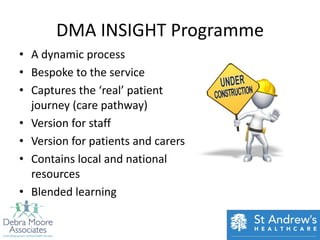Integrated Care Pathways
- 1. Collaborative development of a Forensic Secure Integrated Care Pathway: towards a reduction in length of stay and an improvement in the patient experience Colin Doyle & Debra Moore
- 2. St Andrews – service background • challenging behaviour • secure care pathways • mental health • learning disability, autism • brain injury • adolescents • men, women • older people
- 3. Service Background The Therapeutic Milieu Physical Relational Person Positive Security Procedural Cultural Security Centred Behaviour Security Values & Approach Support Behaviour A charity leading innovation in mental health
- 4. Debra Moore Associates • Organisational Development • Strategic Planning • Service improvement and redesign • Business development • Training including blended learning • Networks and forums
- 5. A partnership on many levels • Between two organisations • Across different sites and services • Across professionals • BETWEEN PEOPLE WHO USE OUR SERVICES, THEIR FAMILIES AND STAFF
- 6. Drivers? • Policy Context – high quality, safe, person centred care • Increased user involvement • Need to articulate the Care Pathway or ‘patient journey’ • CQUINS • QIPP • Regulation CQC
- 7. Common conundrums for health services • How to evidence the care pathway and delivery of timely and effective interventions • How to ensure staff have basic knowledge and understanding of care pathway, assessments, interventions, tools etc • How to ensure all staff are working to national and organisational policies and procedures • How to ensure all staff are aware of and acting in accordance with good practice guidance and research • How to ensure all paperwork is the right paperwork! • How to inform staff development – knowing where the needs and strengths lie within the workforce • How to increase user involvement and promote ‘choice and voice’ • How to create a easy to use system that can manage knowledge and provide relevant data to measure performance
- 8. What can happen? • Confusion • Variable quality • Not person centred • Dehumanising
- 9. Using appreciative inquiry – taking a strengths based approach • When health care is patient centred – what does it look like? • How does it feel? • Need to create a compelling picture and move towards it
- 10. Tell me about a time…… • Ask all stakeholders • Interview each other • Take a ‘slice’ of the organisation • Hear the patient and their carer
- 11. Understanding the patient’s journey Pre- admission Admission Person centred care planning
- 12. Understanding the patient’s journey Treatment Pre Discharge Post Discharge phase Planning Support
- 13. 3 BIG phases Moving Moving Moving in through out
- 14. DMA INSIGHT Programme • A dynamic process • Bespoke to the service • Captures the ‘real’ patient journey (care pathway) • Version for staff • Version for patients and carers • Contains local and national resources • Blended learning
- 15. DMA INSIGHT - ONLINE • Using new techniques to engage • Reduce ‘ring binder’ culture
- 16. Summary • Puts the patient and their experience at the centre; improving patient experience • Clarifies the care pathway and works towards a reduction in length of stay • Supports the ‘frontline’ with tools, resources and learning
- 17. Any questions?
- 18. More information debra@debramooreassociates.com CDoyle@standrew.co.uk

















